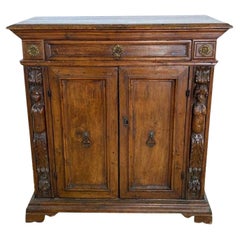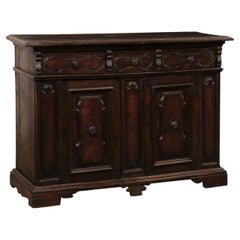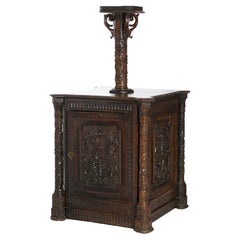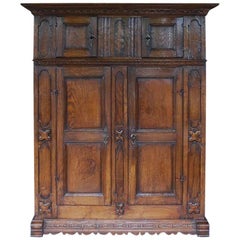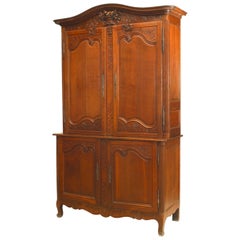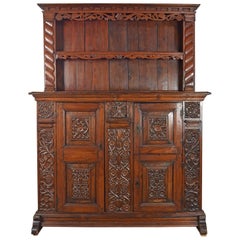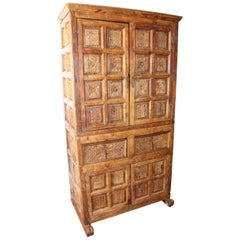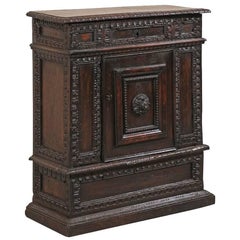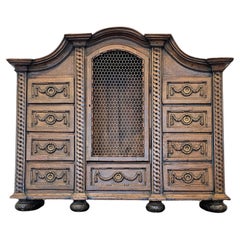18th Century Carved Cabinet
Antique 18th Century Renaissance Credenzas
Ormolu
Antique 18th Century Italian Credenzas
Walnut
Antique 18th Century European Cabinets
Oak
Antique Early 18th Century German Cabinets
Oak
Antique 18th Century French French Provincial Cabinets
Oak
Antique Mid-18th Century German Rustic Cabinets
Pine
Antique 18th Century Bolivian Wardrobes and Armoires
Fruitwood
Antique 18th Century Italian Cabinets
Wood
Antique 18th Century French Baroque Cabinets
Brass
Antique Early 18th Century European Louis XIV Secretaires
Bronze
Antique Late 18th Century French Louis XV Commodes and Chests of Drawers
Walnut
Antique Mid-18th Century French Cabinets
Oak
Antique Early 18th Century French Régence Cabinets
Iron
Antique Early 18th Century Cabinets
Walnut
Antique Late 18th Century Italian Rococo Vitrines
Giltwood, Wood
Antique 18th Century English Buffets
Wood
Antique 1750s Chinese Qing Cabinets
Walnut, Lacquer
Antique 18th Century European Renaissance Revival Cabinets
Walnut
Antique Late 18th Century French French Provincial Cabinets
Oak
Antique Mid-18th Century English Georgian Corner Cupboards
Pine
Antique 18th Century French Louis XIV Wardrobes and Armoires
Wood, Oak
Antique 18th Century Italian Cupboards
Walnut
Antique 18th Century Austrian Baroque Cabinets
Iron
Antique 18th Century French Louis XV Buffets
Oak
Antique 18th Century Credenzas
Fruitwood
Antique Early 18th Century English Gothic Cabinets
Glass, Oak
Antique 18th Century French Louis XV Wardrobes and Armoires
Wood
Antique Late 18th Century European Rococo Cabinets
Iron
Antique 18th Century Indian Dutch Colonial Cabinets
Rosewood
Antique Mid-18th Century Swedish Rococo Cabinets
Brass, Iron
Antique Late 18th Century French Louis XV Shelves and Wall Cabinets
Glass, Walnut
Antique Early 18th Century Spanish Baroque Buffets
Iron
Antique Late 19th Century English Sheraton Cabinets
Wood
Antique Mid-18th Century Danish Rococo Cabinets
Bronze
Antique Early 18th Century French Credenzas
Iron
Antique Mid-18th Century Swedish Rococo Cabinets
Bronze
Antique Late 18th Century French Renaissance Sideboards
Metal
Antique Late 17th Century Renaissance Cabinets
Metal
Antique Mid-18th Century Danish Baroque Cabinets
Walnut
Antique Late 18th Century French Commodes and Chests of Drawers
Bronze
Antique Late 18th Century British Blanket Chests
Pine
Antique Late 18th Century English Georgian Cabinets
Brass
Antique Mid-18th Century Austrian Louis XV Cabinets
Gold Leaf
Antique 18th Century Gothic Dressers
Walnut
Antique Late 18th Century Dutch Renaissance Cabinets
Oak
Antique Early 18th Century French Baroque Credenzas
Oak
Antique 18th Century English French Provincial Wardrobes and Armoires
Hardwood, Oak
Antique 18th Century French Louis XV Sideboards
Iron
Antique 18th Century and Earlier French Wardrobes and Armoires
Fruitwood
Antique 18th Century French Cupboards
Iron
Antique Late 18th Century French Georgian Cupboards
Walnut
Antique 18th Century American Chippendale Commodes and Chests of Drawers
Brass
Antique 18th Century Swedish Baroque Wardrobes and Armoires
Metal
Antique Late 18th Century French Louis XV Cupboards
Oak
Antique 18th Century Italian Cabinets
Wood
Antique 18th Century Spanish Blanket Chests
Wood
Antique 18th Century Belgian Cabinets
Brass
Antique Mid-18th Century Italian Louis XV Wardrobes and Armoires
Fir
Antique Mid-18th Century French Louis XV Corner Cupboards
Walnut
Antique 1760s Italian Cabinets
Wood
- 1
- ...
18th Century Carved Cabinet For Sale on 1stDibs
How Much is a 18th Century Carved Cabinet?
Finding the Right Case Pieces And Storage Cabinets for You
Of all the vintage storage cabinets and antique case pieces that have become popular in modern interiors over the years, dressers, credenzas and cabinets have long been home staples, perfect for routine storage or protection of personal items.
In the mid-19th century, cabinetmakers would mimic styles originating in the Louis XIV, Louis XV and Louis XVI eras for their dressers, bookshelves and other structures, and, later, simpler, streamlined wood designs allowed these “case pieces” or “case goods” — any furnishing that is unupholstered and has some semblance of a storage component — to blend into the background of any interior.
Mid-century modern furniture enthusiasts will cite the tall modular wall units crafted in teak and other sought-after woods of the era by the likes of George Nelson, Poul Cadovius and Finn Juhl. For these highly customizable furnishings, designers of the day delivered an alternative to big, heavy bookcases by considering the use of space — and, in particular, walls — in new and innovative ways. Mid-century modern credenzas, which, long and low, evolved from tables that were built as early as the 14th century in Italy, typically have no legs or very short legs and have grown in popularity as an alluring storage option over time.
Although the name immediately invokes images of clothing, dressers were initially created in Europe for a much different purpose. This furnishing was initially a flat-surfaced, low-profile side table equipped with a few drawers — a common fixture used to dress and prepare meats in English kitchens throughout the Tudor period. The drawers served as perfect utensil storage. It wasn’t until the design made its way to North America that it became enlarged and equipped with enough space to hold clothing and cosmetics. The very history of case pieces is a testament to their versatility and well-earned place in any room.
In the spirit of positioning your case goods center stage, decluttering can now be design-minded.
A contemporary case piece with open shelving and painted wood details can prove functional as a storage unit as easily as it can a room divider. Alternatively, apothecary cabinets are charming case goods similar in size to early dressers or commodes but with uniquely sized shelving and (often numerous) drawers.
Whether you’re seeking a playful sideboard that features colored glass and metal details, an antique Italian hand-carved storage cabinet or a glass-door vitrine to store and show off your collectibles, there are options for you on 1stDibs.
- 1stDibs ExpertNovember 13, 2024To identify 18th-century furniture, you can research your piece in the context of the prevailing styles of the period or consult a certified appraiser or experienced antique dealer. To identify your item on your own, look over it for maker's marks, such as carvings, stamps, brands and labels. Researching the marking can help you determine the maker of your piece, and from there, you can search further to learn more about your particular item. Without a maker's mark, the best approach is to consider the characteristics of the dominant furniture styles during the 18th century. In England, these included William and Mary, Queen Anne, Georgian, Chippendale, Hepplewhite and Sheraton. Some French furniture styles of the 1700s include Louis XV, Louis XVI and Régence. Find a diverse assortment of 18th-century furniture on 1stDibs.
- 1stDibs ExpertApril 5, 2022Yes, wedding rings have a long history, stretching back to ancient Egypt. The first diamond engagement ring was created in 1477 by Archduke Maximillian of Austria. Browse a wide array of vintage and contemporary wedding rings on 1stDibs.
- 1stDibs ExpertApril 5, 2022In the 18th century, art changed in style from Baroque to Rococo and Neoclassicism. Art became more ornamented and idealized during the Rococo period and then shifted toward a style that emulated the artwork of ancient Greece and Rome near the end of the century. You’ll find a variety of fine art on 1stDibs.
- 1stDibs ExpertApril 5, 2022One way to check if your brass candlesticks are from the 18th century is to look for the two seams running lengthwise on either side. This is from when the candlestick was molded in two halves and then soldered together. You’ll find a variety of candlesticks of all shapes and sizes from some of the top sellers on 1stDibs.
- 1stDibs ExpertJanuary 10, 2025The individuals considered the Big Three of 18th-century cartoons are William Hogarth, James Gillray and George Cruikshank. Although the 18th century saw a widespread increase in illustrations in newspapers, these three illustrators were particularly well-known for their work. Hogarth's work was extremely diverse, ranging from serious, realistic paintings and portraits to satirical and moralistic illustrations filled with symbolism. A British caricaturist, Gillray is remembered today for his artworks representing political and social satires, like his political cartoons against George III of England. Despite being a prolific caricaturist, Cruikshank is now most famous for illustrating the works of Charles Dickens. On 1stDibs, find a wide variety of illustrations.
- 1stDibs ExpertApril 5, 2022At the end of the 17th century, Europe went into a frenzy over porcelain. Asian porcelain was highly sought after, and spurred the foundation of the Meissen factory in France, where hard porcelain went on to be made. You’ll find a large collection of porcelain pieces from many of the world’s top sellers on 1stDibs.
Read More
The Ultimate Guide to Types of Tables for the Home
Whether you’re just moving in or ready to give your home a makeover, our guide will give you pointers on tables that are fitting for every room, nook and hallway.
What Exactly Is a Secretary Desk, and What Is It Used For?
The furniture equivalent of a Swiss Army knife, it's the multifunctional piece you didn't know you needed.
This Shelving System with Oxidized Brass Tubes Is Retro and Futuristic at Once
Italian studio DimoreMilano mustered great ingenuity when crafting these sculptural shelves, which are built without any screws.
28 Cheerful Home Bars, Where Everybody (Literally) Knows Your Name
Simple or sophisticated, equipped with console, cart or custom cabinetry, these stylish bar areas deserve a toast.
Ask an Interior Designer: Work-from-Home Edition
Leaping into a design project, whether it's refreshing the bedroom or redoing the whole house, can be overwhelming. Luckily, we know more than a few interior designers. You asked questions on Instagram, and now they're answering.
Collected and Eclectic, ‘Wunderkammern’ Are Back in a Big Way
Introduced nearly 500 years ago, curiosity cabinets are finding new fans among today's collectors and designers.
Meet the Incredible Woman Transforming Fallen Trees into Sleek Furniture
In the hands of New York Heartwoods cofounder Megan Offner, unwanted local trees become works of design art.
These New York Architects Love a Complicated Project
From Brooklyn townhouses to Maine campgrounds, Trattie Davies and Jonathan Toews relish a challenge, like transforming a former warehouse space into the new 1stdibs Gallery.
